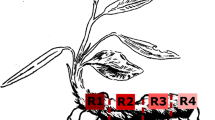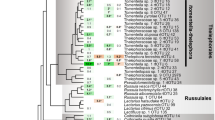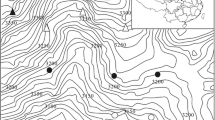Abstract
Numerous species of ectomycorrhizal (ECM) fungi coexist under the forest floor. To explore the mechanisms of coexistence, we investigated the fine-scale distribution of ECM fungal species colonizing root tips in the root system of Tsuga diversifolia seedlings in a subalpine forest. ECM root tips of three seedlings growing on the flat top surface of rocks were sampled after recording their positions in the root system. After the root tips were grouped by terminal-restriction fragment length polymorphism (T-RFLP) analysis of ITS rDNA, the fungal species representing each T-RFLP group were identified using DNA sequencing. Based on the fungal species identification, the distribution of root tips colonized by each ECM fungus was mapped. Significant clustering of root tips was estimated for each fungal species by comparing actual and randomly simulated distributions. In total, the three seedlings were colonized by 40 ECM fungal species. The composition of colonizing fungal species was quite different among the seedlings. Twelve of the 15 major ECM fungal species clustered significantly within a few centimeters. Some clusters overlapped or intermingled, while others were unique. Areas with high fungal species diversity were also identified in the root system. In this report, the mechanisms underlying generation of these ECM root tip clusters in the root system are discussed.

Similar content being viewed by others
References
Arocena JM, Glowa KR, Massicotte HB (2001) Calcium-rich hypha encrustations on Piloderma. Mycorrhiza 10:209–215
Bergemann SE, Miller SL (2002) Size, distribution, and persistence of genets in local populations of the late-stage ectomycorrhizal basidiomycete, Russula brevipes. New Phytol 156:313–320
Conn C, Dighton J (2000) Litter quality influences on decomposition, ectomycorrhizal community structure and mycorrhizal root surface acid phosphatase activity. Soil Biol Biochem 32:489–496
Dahlberg A (1999) Somatic incompatibility in ectomycorrhizas. In: Varma A, Hock B (eds) Mycorrhiza: structure, function, molecular biology and biotechnology -second edition-. Springer, Berlin, pp 110–132
Dahlberg A (2001) Community ecology of ectomycorrhizal fungi: an advancing interdisciplinary field. New Phytol 150:555–562
Dahlberg A, Stenlid J (1994) Size, distribution and biomass of genets in populations of Suillus hovinus (L.: Fr.) Roussel revealed by somatic incompatibility. New Phytol 128:225–234
Erland S, Taylor AFS (1999) Resupinate ectomycorrhizal fungal genera. In: Cairney JWG, Chambers SM (eds) Ectomycorrhizal fungi: key genera in profile. Springer, Berlin, pp 287–309
Fukami T, Dickie IA, Wilkie JP, Paulus BC, Park D, Roberts A, Buchanan PK, Allen RB (2010) Assembly history dictates ecosystem functioning: evidence from wood decomposer communities. Ecol Lett 13:675–684
Gardes M, Bruns TD (1993) ITS primers with enhanced specificity for basidiomycetes—application to the identification of mycorrhizae and rusts. Mol Ecol 2:113–118
Genney DR, Anderson IC, Alexander IJ (2006) Fine-scale distribution of pine ectomycorrhizas and their extramatrical mycelium. New Phytol 170:381–390
Horton TR, Bruns TD (2001) The molecular revolution in ectomycorrhizal ecology: peeking into the black-box. Mol Ecol 10:1855–1871
Izzo A, Agbowo J, Bruns TD (2005) Detection of plot-level changes in ectomycorrhizal communities across years in an old-growth mixed-conifer forest. New phytol 166:619–630
Kennedy P (2010) Ectomycorrhizal fungi and interspecific competition: species interactions, community structure, coexistence mechanisms, and future research directions. New Phytol 187:895–910
Kennedy PG, Peay KG, Bruns TD (2009) Root tip competition among ectomycorrhizal fungi: are priority effects a rule or an exception? Ecology 90:2098–2107
Kõljalg U, Larsson K-H, Abarenkov K, Nilsson RH, Alexander IJ, Eberhardt U, Erland S, Høiland K, Kjøller R, Larsson E, Pennanen T, Sen R, Taylor AFS, Tedersoo L, Vrålstad T, Ursing BM (2005) UNITE: a database providing web-based methods for the molecular identification of ectomycorrhizal fungi. New Phytol 166:1063–1068
Lian C, Miwa M, Hogetsu T (2001) Outcrossing and paternity analysis of Pinus densiflora (Japanese red pine) by microsatellite polymorphism. Heredity 87:88–98
Lian C, Narimatsu M, Nara K, Hogetsu T (2006) Tricholoma matsutake in a natural Pinus densiflora forest: correspondence between above- and below-ground genets, association with multiple host trees and alteration of existing ectomycorrhizal communities. New Phytol 171:825–836
Lilleskov EA, Bruns TD, Horton TR, Taylor DL, Grogan P (2004) Detection of forest stand-level spatial structure in ectomycorrhizal fungal communities. FEMS Microbiol Ecol 49:319–332
Pickles BJ, Genney DR, Potts JM, Lennon JJ, Anderson IC, Alexander IJ (2010) Spatial and temporal ecology of Scots pine ectomycorrhizas. New Phytol 186:755–768
Pickles BJ, Genney DR, Anderson IC, Alexander IJ (2012) Spatial analysis of ectomycorrhizal fungi reveals that root tip communities are structured by competitive interactions. Mol Ecol 21:5110–5123
Richard F, Moreau P-A, Selosse R-A, Gardes M (2004) Diversity and fruiting patterns of ectomycorrhizal and saprobic fungi in an old-growth Mediterranean forest dominated by Quercus ilex L. Can J Bot 82:1711–1729
Rosling A, Landeweert R, Lindahl BD, Larsson K-H, Kuyper TW, Taylor AFS, Finlay RD (2003) Vertical distribution of ectomycorrhizal fungal taxa in a podzol soil profile. New Phytol 159:775–783
Shiraishi A, Komatsu M, Matsushita N, Hogetsu T (2011) Genetic diversity and spatial distribution of rhizobial bacteria nodulating on black locust (Robinia pseudoacacia) rhizospheres. Soil Sci Plant Nutr 57:765–774
Smith SE, Read DJ (2008) Mycorrhizal symbiosis-3rd edition. Academic, London
Tamura K, Peterson D, Peterson N, Stecher G, Nei M, Kumar S (2011) MEGA5: molecular evolutionary genetics analysis using maximum likelihood, evolutionary distance, and maximum parsimony methods. Mol Biol Evol 28:2731–2739
Tedersoo L, Kõljalg U, Hallenberg N, Larrsson K-H (2003) Fine scale distribution of ectomycorrhizal fungi and roots across substrate layers including coarse woody debris in a mixed forest. New Phytol 159:153–165
Tedersoo L, Suvi T, Jairus T, Kõljalg U (2008) Forest microsite effects on community composition of ectomycorrhizal fungi on seedlings of Picea abies and Betula pendula. Environ Microbiol 10:1189–1201
White TJ, Bruns TD, Lee S, Taylor JT (1990) Amplification and direct sequencing of fungal ribosomal RNA genes for phylogenetics. InPCR protocols: a guide to methods and application. Academic, London, pp 315–322
Wu B, Maruyama H, Teramoto M, Hogetsu T (2012) Structural and functional interactions between extraradical mycelia of ectomycorrhizal Pisolithus isolates. New Phytol 194:1070–1078
Yamada A, Katsuya K (1996) Morphological classification of ectomycorrhizas of Pinus densiflora. Mycoscience 37:145–155
Zhou Z, Hogetsu T (2002) Subterranean community structure of ectomycorrhizal fungi under Suillus grevillei sporocarps in a Larix kaempferi forest. New Phytol 154:529–539
Zhou Z, Miwa M, Hogetsu T (1999) Analysis of genetic structure of a Suillus grevillei population in a Larix kaempferi stand by polymorphism of inter-simple sequence repeat (ISSR). New Phytol 144:55–63
Zhou Z, Miwa M, Hogetsu T (2000) Genet distribution of ectomycorrhizal fungus Suillus grevillei populations in two Larix kaempferi stands over two years. J Plant Res 113:365–274
Zhou Z, Miwa M, Matsuda Y, Hogetsu T (2001) Spatial distribution of the subterranean mycelia and ectomycorrhizae of Suillus grevillei genets. J Plant Res 114:179–185
Acknowledgments
We thank Dr. Yukiko Takahashi, a postdoctoral fellow at the Graduate School of Frontier Sciences, The University of Tokyo, and Ryuhei Komatsu from the Graduate School of Agricultural and Life Sciences, The University of Tokyo, for their assistance. The study was supported in part by a Grant-in-aid for Scientific Research (no. 23380080) from the Ministry of Education, Culture, Sports, Science and Technology, Japan.
Author information
Authors and Affiliations
Corresponding author
Rights and permissions
About this article
Cite this article
Yoshida, N., Son, J.A., Matsushita, N. et al. Fine-scale distribution of ectomycorrhizal fungi colonizing Tsuga diversifolia seedlings growing on rocks in a subalpine Abies veitchii forest. Mycorrhiza 24, 247–257 (2014). https://doi.org/10.1007/s00572-013-0535-6
Received:
Accepted:
Published:
Issue Date:
DOI: https://doi.org/10.1007/s00572-013-0535-6




